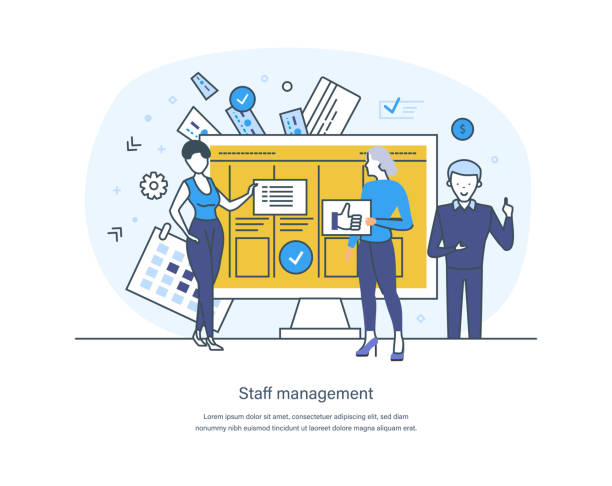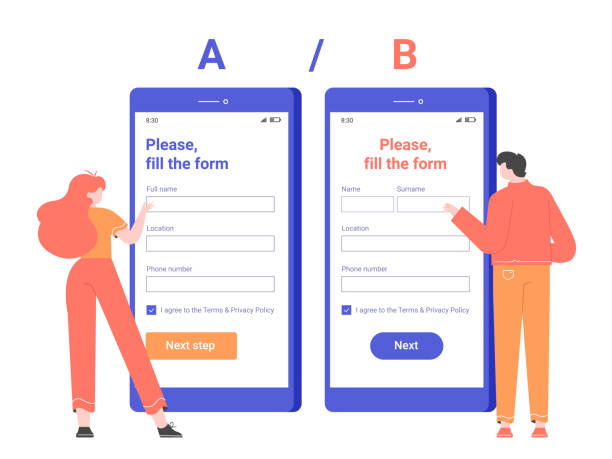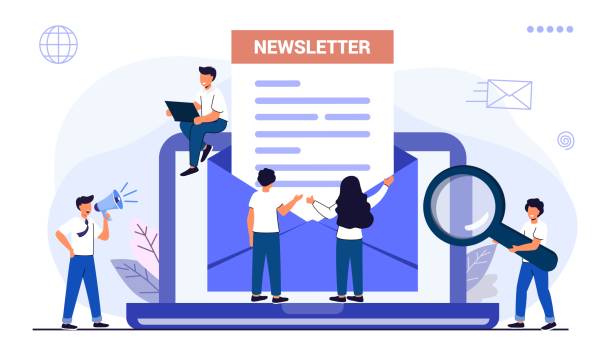Introduction to Web Security and Why It Matters

In today’s world, where all aspects of our lives are intertwined with the internet, #Secure_Website_Design is no longer a luxury choice but a vital necessity.
With the increasing proliferation of cyber threats, from phishing attacks to data theft, ensuring website security has become a top priority for businesses and developers.
This issue is not only limited to protecting sensitive user information but also includes maintaining brand credibility and trust.
Insecure websites can easily become targets for intruders, jeopardizing customer data, financial information, and even trade secrets.
A proper #Educational approach in web security can help organizations fortify their infrastructure against vulnerabilities from the outset.
Furthermore, adhering to the principles of secure website design significantly helps improve SEO rankings and attract more traffic, as search engines prioritize secure websites.
Ignoring this aspect can lead to irreparable consequences, including heavy financial penalties, loss of customers, and damage to reputation.
Therefore, investing in web security is, in fact, an investment in the future and sustainability of a digital business.
Does your company’s website create a professional and lasting first impression for potential customers? Rasaweb, with its professional corporate website design, not only represents your brand’s credibility but also paves the way for your business growth.
✅ Create a powerful and reliable brand image
✅ Attract target customers and increase sales
⚡ Get free consultation
Common Web Vulnerabilities and Countermeasures

Understanding common web vulnerabilities is the first step towards #Secure_Website_Design and securing it.
Attacks such as #SQL_Injection, where an attacker inserts malicious code into program inputs to gain access to the database, or #XSS (Cross-Site Scripting) attacks, which allow the injection of malicious JavaScript code into web pages, are among the most common threats.
Also, CSRF (Cross-Site Request Forgery) attacks, which trick users into sending unwanted requests to a trusted website, can have serious consequences.
Flaws in session management, weak authentication, incorrect server configurations, and the use of vulnerable components in web development frameworks are other common weaknesses.
A #Specialized approach to counter these threats includes using data input filters, encrypting sensitive information, implementing robust authentication and authorization mechanisms, and regularly updating software and libraries.
Developers must constantly stay informed about the latest security news and penetration methods to identify and fix these vulnerabilities promptly, providing a platform with secure website design and protecting their users’ privacy.
Best Practices for Secure Coding and Vulnerability Prevention

Implementing best practices for secure coding forms the core of #Secure_Website_Design and resistance against cyberattacks.
Among the most important of these methods is meticulous Input Validation for all user inputs; this means ensuring that entered data matches the expected format and does not contain malicious code.
Using Parameterized Queries or Prepared Statements to prevent SQL Injection attacks, and Output Encoding to prevent XSS attacks are other fundamental principles.
Additionally, proper Session Management, including the use of random and encrypted session IDs, and expiring sessions after a specified period or user inactivity, is crucial.
As a practical #Guidance, developers should always follow the Principle of Least Privilege, meaning that each part of the system only requires the minimum necessary access to perform its task.
| Vulnerability | Description | Prevention Method |
|---|---|---|
| SQL Injection | Injection of malicious SQL code to access the database | Using Prepared Statements or ORM |
| Cross-Site Scripting (XSS) | Injection of malicious scripts into web pages | Validating and encoding user outputs |
| Broken Authentication | Flaws in user authentication mechanisms | Multi-factor authentication, strong passwords, secure session management |
| Sensitive Data Exposure | Disclosure of sensitive information due to lack of encryption | End-to-End encryption, use of SSL/TLS |
Using modern web development frameworks that have built-in security features and regularly updating them is also part of this comprehensive security strategy.
Furthermore, a strong hashing library should always be used for storing passwords, and passwords should never be stored in plaintext.
Continuous training of the development team on the latest security threats and best practices for secure website design forms the backbone of a secure development environment.
The Importance of SSL/TLS Certificates in Securing Communications

In the information age, where data flows continuously, SSL/TLS certificates play a pivotal role in #Secure_Website_Design.
These certificates, by creating an encrypted communication channel between the user’s browser and the website’s server, ensure that all exchanged data, including login information, credit card numbers, and personal information, remains safe from unauthorized access.
Without SSL/TLS, data is transmitted in plaintext, and any attacker can easily access it by eavesdropping on the network.
From the user’s perspective, the presence of a green lock icon in the browser’s address bar signifies trust and confidence in the website’s security.
This directly impacts user experience and their willingness to perform transactions or enter sensitive information on your website.
From a #Specialized perspective, SSL/TLS prevents Man-in-the-Middle attacks and verifies the server’s identity for the user.
Furthermore, search engines like Google prioritize websites with SSL/TLS in their search rankings, which significantly helps improve website SEO and increase organic traffic.
Therefore, implementing SSL/TLS certificates is a fundamental and essential action for any website seeking secure website design and to maintain user trust.
Do you know that the first impression customers have of your company is your website? With a powerful corporate site from Rasaweb, multiply your business’s credibility!
✅ Custom and eye-catching design tailored to your brand
✅ Improve user experience and increase customer attraction
⚡ Get a free website design consultation!
Server and Network Security; The Backbone of Website Security

Server and network security is the underlying and vital layer for any #Secure_Website_Design.
Even with secure coding and SSL, if the server and network infrastructure have vulnerabilities, the website will be at serious risk.
Implementing powerful firewalls, intrusion detection and prevention systems (IDS/IPS), and regular updates of the operating system and server software are among the #Specialized measures in this field.
Firewalls filter incoming and outgoing traffic and prevent unauthorized access, while IDS/IPS identify suspicious traffic patterns and take preventive actions.
Also, secure configuration of services, disabling unnecessary ports and services, and using strong passwords for administrative access are of high importance.
Continuous monitoring of server logs to identify suspicious activities and regular backups of data and server settings are also essential.
This #Guidance-oriented approach allows system administrators to build a robust server environment, laying a strong foundation for secure website design and ensuring the overall stability and security of the website.
User Authentication and Authorization; Access Management

Authentication and Authorization are two fundamental pillars in #Secure_Website_Design that directly impact user #Access_Management.
Authentication refers to #Identity_Verification of the user, often done using a username and password.
However, in today’s world, a password alone is not enough.
Implementing Multi-Factor Authentication (MFA), such as sending a code to a mobile phone or email, significantly increases the security of user accounts and prevents brute-force attacks.
On the other hand, authorization determines the level of access each user has to website resources and functionalities.
This means implementing a Role-Based Access Control (RBAC) model, where each user has access to specific functionalities based on their role (e.g., administrator, editor, regular user).
This #Specialized approach ensures that even if a user account is compromised, the attacker cannot access all parts of the system.
A secure website design system should regularly review user access levels and remove unnecessary permissions.
Furthermore, implementing strong password policies, including requiring the use of uppercase and lowercase letters, numbers, and symbols, and periodically changing passwords, are important #Educational measures for users that play a significant role in enhancing overall website security.
Regular Security Audits and Penetration Testing

After implementing the principles of #Secure_Website_Design, the process of regular security audits and #Penetration_Testing is essential as vital layers for discovering and fixing hidden vulnerabilities.
Security audits are comprehensive reviews of code, server configuration, and security processes performed by internal teams or external experts.
The goal of these audits is to identify potential weaknesses before attackers discover them.
Penetration testing, which can be called a controlled simulated attack, evaluates the effectiveness of a website’s defense mechanisms against real attacks.
This practical #Analytical approach shows how an attacker can infiltrate the system and what information they can obtain.
Penetration test results provide a comprehensive report of vulnerabilities and suggestions for their remediation.
| Step | Description |
|---|---|
| Planning and Information Gathering | Defining objectives, scope, and gathering initial information about the system |
| Vulnerability Identification | Automated and manual scanning to discover security weaknesses |
| Exploitation Attempt | Simulating attacks to confirm and evaluate the impact of vulnerabilities |
| Analysis and Reporting | Preparing a comprehensive report including vulnerability details and remediation solutions |
| Remediation and Verification | Applying corrections and re-testing to ensure complete resolution of issues |
These processes should be repeated periodically and after any significant changes to the website to ensure its continuous security.
OWASP Top 10 is an excellent resource for starting to identify common vulnerabilities.
Performing these reviews not only helps increase security but also significantly increases user trust in your online services.
Data Privacy and Compliance with Legal Standards

Alongside the technical aspects of #Secure_Website_Design, #Data_Privacy and compliance with legal standards such as GDPR and CCPA are also of high importance.
These regulations not only protect users’ personal information but also impose significant legal responsibilities on businesses that handle this data.
For example, GDPR (General Data Protection Regulation) in the European Union provides extensive rights for users regarding their data and obliges companies to adopt appropriate security measures, obtain explicit user consent for data collection, and allow users to delete or edit information.
Non-compliance with these laws can lead to very heavy financial penalties and severely damage the business’s reputation.
From a #News perspective, many large companies have faced legal issues due to privacy breaches or insufficient data protection.
These incidents emphasize that data security is no longer just a technical issue but a serious legal and ethical matter that directly impacts secure website design.
Implementing transparent privacy policies, using encryption for data at rest and in transit, and ensuring that all data collection and processing comply with legal principles are essential for any website seeking sustainability and user trust.
Are you tired of your company’s website not meeting your expectations? With Rasaweb, design a professional website that truly represents your business’s image.
✅ Increase attraction of new customers and sales leads
✅ Enhance your brand’s credibility and trust with your audience
⚡ Get a free website design consultation!
Incident Response and Disaster Recovery

Even with adherence to all #Secure_Website_Design principles, no website is completely immune to cyberattacks.
Therefore, having a comprehensive #Incident_Response and #Disaster_Recovery plan is vitally important.
An incident response plan includes a set of actions and protocols that the security team must follow in the event of a cyberattack (such as intrusion, DDoS attack, or data breach).
This plan should include phases of identification, containment, eradication, recovery, and post-incident analysis.
The main goal is to minimize damage, quickly restore services, and prevent recurrence of the incident.
From a #Specialized perspective, this plan should include team training, role and responsibility definition, and simulated exercises to ensure its effectiveness.
On the other hand, the disaster recovery plan focuses on restoring systems and data after a major event (such as hardware failure, natural disasters, or destructive attacks).
This involves regular and reliable backups of all data and configurations, storing these backups in secure and separate locations, and having a clear strategy for restoring systems as quickly as possible.
These #Guidance-oriented approaches ensure that even in the worst-case scenarios, a digital business can quickly resume operations and prevent prolonged service interruptions.
The Future of Web Security and Continuous Improvement

The world of web security is constantly evolving, and attackers are always looking for new ways to infiltrate.
Therefore, #Secure_Website_Design is not a one-time process, but a cycle of #Continuous_Improvement.
Future trends in web security include the use of #Artificial_Intelligence and #Machine_Learning to detect anomalies and more advanced attacks, the implementation of Zero Trust architecture where no user or device, even within the internal network, is trusted by default, and increased use of blockchain for data security and authentication.
Also, cyber-physical security, which covers the connection between digital systems and the physical world, is becoming a major concern.
To maintain website security against new threats, organizations must actively invest in cybersecurity research and development and equip their teams with the latest knowledge and technologies.
Attending security conferences, studying #Analytical reports on new attacks, and collaborating with the cybersecurity community can all help organizations stay one step ahead of attackers.
This #Thought_Provoking_Content approach reminds us: are we sufficiently prepared for future security challenges? And how can we ensure that our secure website design will remain effective for years to come? This dynamism in web security makes it an #Engaging and yet critical field for developers and IT professionals.
Frequently Asked Questions
| No. | Question | Answer |
|---|---|---|
| 1 | What is secure website design? | The process of designing and developing websites that are resilient to cyberattacks and protect user data and privacy. |
| 2 | Why is website security important? | To prevent data breaches, financial losses, damage to company reputation, and maintain user trust. |
| 3 | What are some common website security threats? | SQL Injection, XSS (Cross-Site Scripting), CSRF (Cross-Site Request Forgery), weak authentication, and unpatched software. |
| 4 | What is SSL/TLS and what is its role? | Protocols for encrypting data between the user’s browser and the website’s server, ensuring secure and private communication. |
| 5 | How can SQL Injection attacks be prevented? | By using Prepared Statements/Parameterized Queries, input validation, and ORMs (Object-Relational Mappers). |
| 6 | What is the role of a Web Application Firewall (WAF) in security? | A WAF monitors and filters HTTP traffic between a web application and the internet to prevent malicious attacks. |
| 7 | Why is regular updating of software and libraries essential? | Updates include patches for known security vulnerabilities that attackers can exploit. |
| 8 | How can XSS attacks be prevented? | By sanitizing and escaping all user inputs before displaying them on the web page and using a Content Security Policy (CSP). |
| 9 | What is the Principle of Least Privilege? | It means that users and systems are given only the minimum permissions necessary to perform their tasks, to prevent unnecessary access to resources. |
| 10 | What is the importance of proper user session management? | To prevent session hijacking and unauthorized access to user accounts through secure and expiring session tokens. |
And other services of RasaWeb Advertising Agency in the field of advertising
Reviewing the impact of mobile advertising on commercial advertisements for pet supplies
How to use personalized ads to attract target customers for pet supplies
The role of realistic ads in increasing sales of pet supplies
Reviewing the impact of digital media on commercial advertisements for pet supplies
How to use live ads on commercial websites for pet supplies
And over a hundred other services in the field of internet advertising, advertising consultation, and organizational solutions
Internet Advertising | Advertising Strategy | Advertorial
🚀 To be seen in the digital world and reach the peak of success, Rasaweb Digital Marketing Agency is with you. By providing specialized services including professional WordPress website design and targeted SEO, we elevate your business to the position it deserves. For a free consultation and to start your business’s digital transformation, contact us.
📍 Tehran, Mirdamad Street, next to Bank Markazi, Kazerun Jonoubi Alley, Ramin Alley, No. 6

